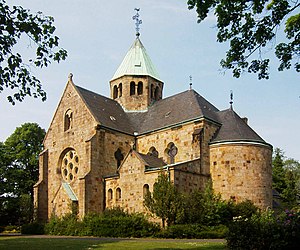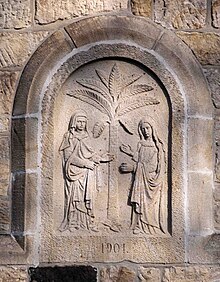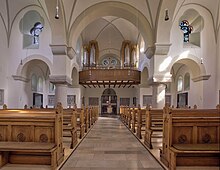St. Mary's Visitation (Hauenhorst)
The Church of St. Mary's Visitation is the Catholic parish church of the parish of the same patronage in Hauenhorst near Rheine . Since 2012 it has been one of the three churches of the Parish Association of St. John the Baptist, consisting of the formerly independent communities Hauenhorst, Elte ( St. Ludgerus ) and Mesum ( St. Johannes Baptist ). The patronage of the Visitation of the Virgin Mary relates to an event from Mary's life : Mary's visit to Elizabeth . The patronage festival is celebrated on May 31st.
history
A teacher in Hauenhorst succeeded in building a small village school in the southwest of the then small farming community in Hauenhorst in 1783 , to which he added an extension that he wanted to use as a school chapel. From 1790 the Holy Mass could be celebrated here. This displeased the Rhenish clergy , as they feared financial losses for their churches, as the St. Dionysius Church was about to be completely redesigned in accordance with the baroque taste of the time. Hauenhorst belonged legally to her parish and was therefore subject to tax. However, the Hauenhorster obtained permission to use their chapel in a higher position. The pastoral care was taken over by the Franciscan fathers who had lived in Rheine since 1635.
This school chapel quickly turned out to be too small and the fabric of the building was not worth preserving. Thus a successor to the village school teacher managed to build a separate chapel in solid rubble, which was completed in 1808. From the outside, the building was in the classicist Baroque style of Dutch style with three large windows in the side walls, a simple stepped gable with a semicircular end and a roof turret . Nothing is known about the interior.
This building too became too small at the end of the 19th century, so that a larger church building had to be considered again. In 1893 the Bishop of Münster granted the building permit. Due to large building projects in the neighboring Rheine (new construction of the St. Antonius Basilica ), planning for the small village church in Hauenhorst was slow. The art-loving pastor of St. Antonius, Dechant Pietz, was responsible for the building. He appointed the architect of his building project, a large basilica for the district to the right of the Ems, for the more modest project in Hauenhorst. The German-Dutchman Franz Klomp was now responsible for two new church buildings within the city limits of Rheine and the village church in Hauenhorst thus became a "by-product" of the representative basilica in Rheine. This is evident not only in the stylistic similarity of the projects, but also in the fact that in some cases the same artists were entrusted with the design of both buildings. Klomp's first plans were available in 1899, the laying of the foundation stone was celebrated in July 1900 and in March 1902 the new church was given its function with the consecration.
Building description
Just like the basilica in Rheine, the new church in Hauenhorst presents itself as a work in the style of Neo-Romanesque (a specialty of the architect). The formal language is that of the German Romanesque of northern Germany, but supplemented by that of the late Romanesque from the Lower Rhine .
The building consists of a three-bay hall with a semicircular choir apse . This longitudinal building is penetrated by a three-bay transept of the same height , based on the Rhenish model . The result is a square crossing and the interior of the church becomes the central building (the same central building experiment, only in neo-Gothic forms, the architect Hilger Hertel the Elder ventured at the same time when building a new church in Mesum). In the corners created between the naves, lower, square rooms are inserted. They create a three-aisled structure which, together with the windows in the main nave, allow the church to be classified as a basilica.
Interior
Inside, the massive, short-stemmed columns are immediately noticeable. Three of the four flat capitals are unfinished and only roughly hewn. Only the fourth, north-eastern capital shows scenes from the life of a farmer who goes about his day's work. Angels do this work so that he finds time for his prayer. It is probably an episode from the legend of the saints of St. Isidore of Madrid . This is a representation with which the Hauenhorst rural population should identify. Otherwise there is almost no figural jewelry in the interior. Only in the outer wall of the choir apse is the church's dedication stone from 1901 set into the wall. It shows the patronage scene in a relief : the encounter between Mary and Elizabeth.
The interior is dominated by the windowless, semicircular apse. The architectural design makes the interior of the church appear massive and pressed. This corresponded to the idea of the Romanesque at the time as difficult, defensible and primeval.
Furnishing
Financially speaking, building the new church was an immense project for the small community. After the completion there was no money for a rich interior. Nevertheless, the church has a number of noteworthy objects.
- Vesper picture ; 1st half of the 15th century; dark stained softwood; repeatedly restored; Donation from the builder Dechant Pietz from his own art collection to the community.
- Figure of Anthony of Padua with the Christ child; around 1800; Baumberger sandstone ;
- 14 stations of the cross by Heinrich Fleige ; Created between 1885 and 1890. The proportions of the Stations of the Cross, which are unsuitable for the rather small church, can be explained by the fact that these depictions of the Passion were originally created for the much larger Dionysius Church in Rheine, but could not be installed there for structural reasons. So they came to Hauenhorst. Stylistically, they are reminiscent of works by the German Roman Wilhelm Achtermann , whose Pietà for the cathedral in Münster caused a sensation at the time and found many imitators.
- Pews and inner wings of the main portal; Carvings by the sculptor Theodor Appelmann, who also worked on the basilica in Rheine. According to popular opinion, the representation of a pigeon standing on its nest justifies the name Taubendorf for Hauenhorst. Appelmann understood the dove and the unicorn depicted next to it as Marian symbols (representation of the Holy Spirit at the Annunciation in the form of a dove. The legendary unicorn can only be captured by a virgin. Mary here symbolizes the virgin, Jesus for the unicorn) .
- Baptismal font ; Sandstone and marble with bronze lid without figurative decoration; 1908.
- Eternal light ; Early 20th century; filigree gothic design in shiny gold bronze.
- Statues of St. Joseph and St. Anna by Anton Rüller (a pupil of Heinrich Fleige); gray glazed limewood in the style of the Nazarenes .
- Two confessionals built in the transept niches from 1935 by the sculptor Albert Karl Kalthoff from Rheine. Semicircular essays depicting the Good Shepherd with the Latin translation Pastor Bonus and the Prodigal Son with the greeting Pax tecum (Latin: "Peace be with you!").
After the Second World War , the old painting no longer seemed up to date. In the course of the redesign of the interior, the church painter Ludwig Baur from Telgte was commissioned to paint the apse in 1956 . The result was the depiction of Christ as the judge of the world , enthroned on a rainbow with Mary and John as secondary characters.
organ
It was not until 1925 that the parish had the necessary financial means to purchase an organ . The Fleiter workshop set up an instrument with 16 sounding stops on a wooden gallery that was only built in at this point in time , divided between two manuals and a pedal with a pneumatic action . The organ was later expanded to include two more stops. 1992 followed by a modernization of the instrument by the existing wind loading by grinding shop and the existing pneumatic Regierwerk by a mechanical key action and electrical key action have been replaced.
The disposition is:
|
|
|
|||||||||||||||||||||||||||||||||||||||||||||||||||||||||||||||
literature
- Rudolf Breuning: The art and cultural monuments in Rheine; Part IV: The monuments in Else, Hauenhorst and Mesum. Tecklenborg Verlag, 2011.
Web links
- Hauenhorst - The story of a village on the website of the Heimatverein Hauenhorst
- Our church building website of the Catholic parish of St. John the Baptist in Rheine
Coordinates: 52 ° 14 ′ 16.2 ″ N , 7 ° 27 ′ 6.1 ″ E












